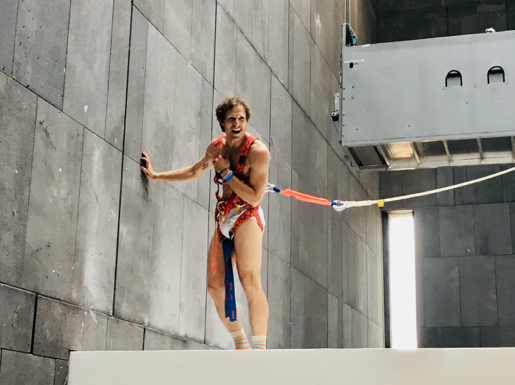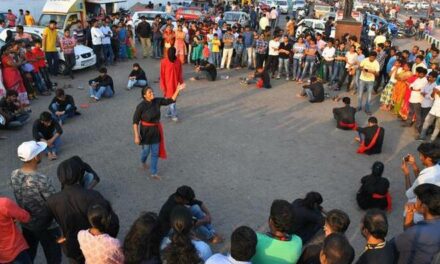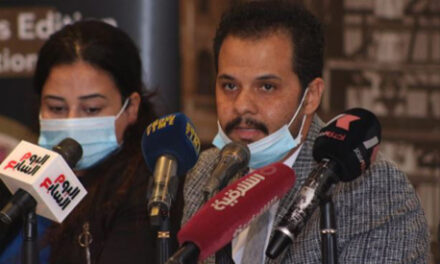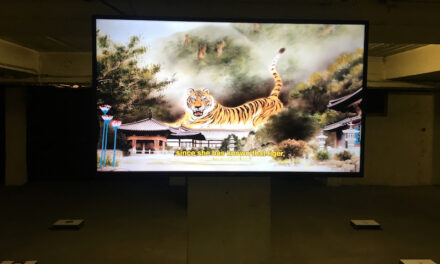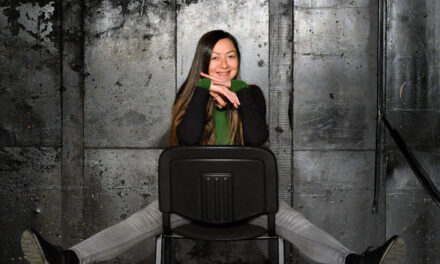Researcher and critic Lisa Moravec explores how two performances of this year’s ImPulsTanz, Vienna’s International Dance Festival, challenge our understanding of a mechanized body-based politics of dressage.
Peter Stamer’s and Frank Willens’s In the Penal Colony and Willens’s group dance Radiant Optimism animate sensuous bodily feelings of dressaged animality—that are immanent in a collectively performed ethics of moving and speaking bodies.
Floating within an international dance festival can be an extremely emotional and diverse experience, as each performance takes you for a different ride and animates distinct feelings and thoughts.
My effective and emotional responses to part of the 36th edition of ImPulsTanz – Vienna International Dance Festival (11 July-11 August) were varied and of different intensities. Overall, the program was rich in aesthetic experiences. It comprised of 65 performances, 237 workshops, and the daily outdoor sessions, Public Moves, offered various opportunities to get a taste of the bodywork of the participating practitioners, which was free and open to all.
The line-up brought together works by emerging and established dancers and choreographers, reaching from reanimations of minimal and conceptual works (such as Jérôme Bel’s re-making of John Cage’s performative work Lecture on Nothing and Jonathan Burrows’ card trick performance Rewriting) to more recent experimental approaches towards performance-making (such as Mette Ingvartsen’s narrative-led solo dance 21 pornographies and Lisbeth Gruwez’s physical-auditive explorations of an all-female dancer cast in The Sea Within).
Two of the staged performance works continue to strike a particular chord in me. One was the theatrical interpretation of Franz Kafka’s parable, In the Penal Colony, by the German performance maker Peter Stamer, performed by the Berlin-based Californian dancer and performer Frank Willens, and the other, Willens’s own group dance, Radiant Optimism, which operates in between conceptual and sensuous bodywork.
Perhaps I’m still moved by them because of their frank and critically performative reconsiderations of the collective ethics of bodily dressage, a bodily mechanism by which we, the so-called political animals are all affected. All our bodies are dressaged to perform, on or offstage, in daily life. We train, and some are trained to perform aesthetic movements on the stage. In this sense, human bodies are both, the objects of dressage, as they are conditioned to perform in a particular manner, as well as dressage’s subjects as they train to be able to perform.
Bodies are dressaged in relation to their socio-political environments, within which they operate, collaborate or sometimes cruelly works against. Stamer’s and Willens’s performance work, In the Penal Colony, skilfully demonstrates the latter to me.
Yet, dressage is not only inscribed onto bodies from the outside and transforms their organic rhythms, which can—in the most extreme case turn into physical torture, it also simultaneously evolves from humans’ embodied feelings of dressaged animality. A visceral feeling that radiates from the inside out, and can affect the socio-political system through their vibrating bodily e-motions.
The latter bodily sense of dressage’s corporeal animality, as my body thinks, is engendered in the group dance Radiant Optimism.
Dressage, A(s) Cruel Pleasure
Peter Stamer’s narrative-led performance, In the Penal Colony, takes Franz Kafka’s unsettling parable, with the same title, as a point of departure to stage a physically intense, disturbing, and affectively unsettling performance. It brings Kafka’s cruel visual images of the most extreme bodily practice of dressage, a brutal torture process, to life.
Kafka’s short story was written at the beginning of World War I. In his fictitious, open-ended parable, a foreign traveler is invited into an unnamed country, a penal colony, to observe a casual execution of a prisoner, conducted by an officer with his killing machine.
Stamer’s reinterpretation and partly new English translation of this text was presented as a dialogical monologue between performer and viewers. It is an experimental work in progress, coming fresh off their two-week residency inside the brutalist architecture of the mumok (Vienna’sMuseumofModernArt) at the end of July.[1]
The performance’s imaginative killing procedure commencers with us, the audience looking up to the officer, performed by Willens, walking down the metal staircase of the museum, tagging along the condemned, the mute performer Zoran Docmanovič who is attached to the officer’s body with a heavy chain. Once they have arrived on the ground floor of the museum, the officer verbally and gesturally introduces us to the operations of the colony’s killing machine, demonstrated inside a heavy cart, Willens and Docmanovič pull themselves up to the ceiling of the museum in that same metal machinery. And we, the audience, are told to move up to the to us assigned staircase. Its balconies face the open space of the museum, where Heimo Zobernig’s literally ‘white cube’ installation connects the two sides of the museum.
The cruel killing show continuous upstairs, inside the cart and on top of the art installation. Having also arrived up in the air, Willens takes a straddle-legged seat on the metal ladder inside the cart and precisely describes how the machine’s harrow, made of glass, is to aesthetically write the death sentence onto the body of the convicted. Long and short needles, pierce through the body, inscribe it, make its warm bloodstream out over a course of twelve hours.
Willens’s verbal performance is captivating to watch until he asks,
Don’t you want to come closer and see the needles for yourself?
As the operations of the machine are transparently presented, the mechanism of the most extreme dressage—the killing process of the condemned—is exposed. This draws attention to the safe distance from which we are watching the dialogically presented monologue.

Frank Willens in In the Penal Colony by Stamer and Willens, performed at mumok. Photo by Ilya Noe.
The core of Stamer’s performative reading of the short-story also challenges Kafka’s critical take on cruel punishment of other bodies, the most extreme and nonetheless pleasureful dressage procedure. While Kafka’s traveler interferes in the barbaric execution process and tells the officer that he does not support the proceedings in the colony, Stamer’s performer provocatively addresses the audience by asking us, the viewers, if we are opposed to the procedure, if we did not like his exhibition of the killing machine.
These words touch a sensitive nerve in me as they prompt to reconsider the ethical attitude that each one of us has towards physical punishment.
What would you do as a foreigner,
in such a site-specific event,
in a country to which you don’t belong?
Would you interfere, if you knew
that someone is not only about to be
tortured but killed in the end?
In Kafka’s story, the traveler expresses his rejection. In the performance, Willens points towards the words BE JUST, the officer’s own guilt sentence which he has just written onto the wall of the museum before he, now performing the condemned himself, is about to have himself killed by the operations of his very own machine. The performer then invites us to imagine how the officer’s machine stabs—not writes—these words into his body when he shouts,
Help me! Help me! Help me!
Of course, no one in the audience moves drastically—as they know this it is not real, it’s only a theatrical performance that merely happens inside one’s mind and doesn’t do much to our bodies.
Nonetheless, Stamer’s visually rich dramaturgy and Willens’s performative interpretation of the surreal Kafkaesque parable gives several incentives to reconsider how human agencies can indeed interfere in apparently legitimatized physical torturing procedures, once the mechanisms of their human dressage processes have been laid bare. The theatrical performance and the text adaptation prompt to re-configure how our own effects and ethics—one’s own embodied dressaged animalities, as I call it—are (sometimes) legitimately played out in a cruel, apparently ice-cold but at the same time pleasureful manner towards others, including oneself.
At the end of Kafra’s story, the foreign traveler leaves the penal colony, the soldier and rescued prisoner, who want to follow him, behind on a boat, preciously because he dared to interfere in the colony’s attitude towards the process of bodily dressage which led to the suicide of the officer. But the departure of the foreigner is not part of the performance that we get to see at the mumok. Instead, we have to leave the museum again, the site of the post-dramatic, narrative-based, cruel killing performance and the performers stay on, for a bit longer.
Dressaged Animalities in Radiant Optimism
A couple of days after this cruelly haunting performance was presented, Frank Willens’s group dance choreography, Radiant Optimism, was on show at the ImPulsTanz festival. In many ways, it seems to juxtapose the dark and heavy performance In the Penal Colony. And yet, the works are connected as each of them stages a particular mechanism of dressage, provoked by the performers’ embodied feelings of dressaged animality. While Stamer’s and Willens’s performance work feeds on the cruel pleasure of killing, the dance Radiant Optimism comes into being through the performers’ optimistic visceral energies. Willens and his four dancers collectively negotiate socio-culturally dressaged bodily movements, as they fully embody their individual sensuous feelings of a dressaged animality and express it through their bodily movements.
The dance performance starts with the zestful performers hanging out in the entrance hall, seeking eye contact with members of the waiting audience. The female performers—Angelina Hoffman, Mariana Nobre Vieira, and Nadine Milzner—are dressed in quotidian dark or colored T-shirts, leggings or shorts. While Vieira has an imprint of Super Mario and Hoffman of a skeleton on her chest, the male dancers—Tomi Paasonen and Willens himself—are dressed in pastel colored tight leggings, tights, and (T-)shirts.
Their dressed and trained bodies not only performatively queer culturally inscribed gender norms, they also simultaneously underline the dancers’ virtuous, partially by classical ballet training informed bodily dress-aged movements and graceful poses.
In the following hour, the performers exhaust themselves in full-body presence in dance work. Their bodies radiantly vibrate to Alex Nickmann’s music that also contaminates the audience’s heartbeats. Group and solo dancing tableaux vivants are lightened up by pas-de-deux sequences. The bodies of the dancers are in constant movement, even when one of them moves solo on the flat white stage.
Although the dance seems to be fully choreographed and marks virtuous heroic and uplifting ballet poses mixed with contemporary gestures, the dancers’ individual bodily movements nonetheless appear natural. They give the impression that their movements radiate freely from the insides of their bodies out, blending in with the colors of their everyday-looking costumes, rather than from the choreography in.
Their bodily e-motions ignite a sense in me, namely that Willens’s utopic, pastel-color group dance fully embodies and projects a feeling of dressaged animality. The performers move sensuously. They flow collectively through the stage. They dance their hearts out inside the enclosed space of the Kasino am Schwarzenbergplatz, in Vienna’s city center.

From left to right: Tomi Paasonen, Frank Willens, Mariana Nobre Vieira, Nadine Milzner, Angelika Hoffman in Frank Willens’ Radiant Optimism. Photo by Karolina Miernik.
This illusion, however, starts to fall apart when the performers lend their facial and bodily movements to recorded voice-overs, that loudly repeat—time and again—script fragments from John Cassavetes’s drama A Women under The Influence(1974). Impersonating the following words in accelerating syncopated times, they start to project the desire of becoming other,
I am not superman.
Who do you think I am? Superman?…
Tell me what you want me to be. How you want me to be.
I could be that. I can be anything. You tell me.
The collective, looping identity crisis comes to a halt when Willens opens one of the doors at the back wall of the stage. Bright light falls onto the dance floor. Looking straight to what is behind the door, through his black sunglasses, he says in a bittersweet self-ironic voice,
I just wanted to let you know, I am really feeling it.
The interval happens before he loudly starts drumming and singing lines from Ian Curtis’s Insight over again,
I am not afraid anymore, I keep my eyes on the door.
These text passages might appear to be a Untermalung, a flat and intentionally low textual coloring. They however effectively play with the unconsciousness of us, the viewers, that which is full of human desires and connected our individual and collective mind and bodily cultural dressage.
Writing from my embodied view, Willens’s dance choreography challenges concepts of naturalistic and realistic body-based acting. The bodies of the dancers continuously speak to the audience through their emanating and vibrating movements whilst, from time to time, injecting rhythmic earworm lyrics. Just as pleasure fluctuates between pain and delight, realism and illusion, texts and bodies, free and restricted, choreographed and improvised movements, Radiant Optimism connects socio-political ingrained methods of dressaging the body through dance, which shape its movements but simultaneously feeds on its feelings of embodied animality.

From left to right: Nadine Milzner, Mariana Nobre Vieira, Frank Willens, in Radiant Optimism. Photo by Karolina Miernik.
It is this crux, operating between body and text-based, as well as between socio-political and embodied feelings that the mechanisms of dressage generate. The group dance paints a pastel-colored, even more, abstract picture of the socio-political operations of bodily dressage than In The Penal Colony does—partly because it does not seem to follow a literally choreographed performative narrative. Radiant Optimism integrates fragments of citations to add to the intensively physical gestures and bodily e-motions, loosely montaged into colorful tableaux vivants. The movement language of the dance seems to have largely fallen into pieces by chance, by collectively exploring both its form and content.
My own body feels much more connected to the physically vibrating performance of Radiant Optimism—perhaps because of its positively affirmative energies and its invitation to directly feel with the performers, to feel some of their moving dressaged animalities. Put into this fluid state of feeling, with my mind floating around in the space, the dance reminds me of the crystal spectrum of feelings that I am embodying, my very own dressaged animalities.
And the recited sentences of John Cassavete’s drama, to which the dancers in Radiant Optimism collectively move, are all but a reminder that they need to be optimistically performed, as there is
no sense in talking about the past.
The past is the past, and that’s dead.
Good times from now on, that’s what we are going to have.
It will get better and better and better,
and better than that.
Cruel and Optimistic Pleasures: Ethics of Collaboration
Ultimately, Radiant Optimism and In the Penal Colony are both concerned with how subjective ethics can perform a collectively affirming politics of the flesh that is motivated by, and in turn animate, sensuous bodily feelings.
The performance of one’s dressage, whether is it a cruel or optimistic pleasure, is ‘a model for subjectivity in general’, as Lauren Berlant neatly puts it in her book Cruel Optimism. To her, it is bodily dressage that ‘scrambles the distinction between forced adaptation, pleasurable variation, and threatening dissolution of life-confirming norms’.
Although the two performances operate within two distinct registers of performance making, and address two different kinds of bodily dressage and feeling, they both bring to the stage an ethical—duo or group—collaborative practice that effectively disturbs images of bodily torturing and (re-)animate given states of pre-conditioned and dressaged affairs of feeling and being. In the Penal Colony and Radiant Optimism prompt taking up opportunities which equally move the mind and the body.
Put into the larger socio-political picture, their wordily and physically entangled works remind of distinct pleasures and desires that can challenge the dark political future outlook. The future might be bleak, in many aspects, but we all have a choice, as the American philosopher Norman Chomsky reminds, to be either pessimistic about it and give up, or to be optimistic and dare to make decisions that may make the world a better communal place.
Running on two parallel tracks, each performance points towards a dialogical hopeful future, in which dressaged bodies can move together, away from romantic passions and illusions towards an alternative form of reality. The dialogue between the two works, one drawing attention to how painful conditions and pleasureful cruelties can be changed, and the other, to the passions that are implicit in utopic bodily affairs of dressage, smear what is considered painful and delightful, just and unethical, good and bad.
Through their works, Stamer and Willens recall that pleasurefully dressaged animalities are part of humanity and its socio-political dressage practices ultimately activate the viewers’ empathy towards others, towards what and who we look at.
Shifting ways of thinking from how the body is punished and inscribed by cruel torturing techniques of dressage within a political system to a critical reflection of how our embodied dressaged animalities can optimistically attempt to shape socio-political experiences within the system is integral to our, all, future dressage practices.
[1]Stamer and Willens have previously collaborated on the performance of Friedrich Nietzsche’s essay, On Truth and Lie in an Extra-Moral Sense (1873), which was also premiered at Impulstanz in 2016 before touring internationally.
A version of this article was originally posted at exeuntmagazine.com and has been reposted with permission. To read the original article, click here.
This post was written by the author in their personal capacity.The opinions expressed in this article are the author’s own and do not reflect the view of The Theatre Times, their staff or collaborators.
This post was written by Lisa Moravec.
The views expressed here belong to the author and do not necessarily reflect our views and opinions.

